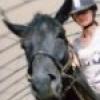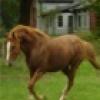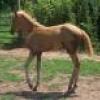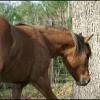Can you guess why she should not be bred?
Forums
Re: Can you guess why she should not be bred?
There are several like joint stress....essentially, I would not be improving the breed to keep this trait in the family! It is said that a horse with legs like this could never compete in upper level competition without damage or break down.
Here's a better showing of the sickle hocked, though she usually stands just camped out as the first pic shows, rarely where it shows this sickle hocked look:
Re: Can you guess why she should not be bred?
Sigh, ya. Such a bummer....I love to watch her. It's the camped out thing, not specifically sickle-hocked, but I guess it's a five dollar bill or five ones?
[img]http://i694.photobucket.com/albums/vv30…]
[img]http://i694.photobucket.com/albums/vv30…]
Re: Can you guess why she should not be bred?
PS - we think the spots are scars. During the summer, they are just practically bald spots. We don't know for sure, but we suspect a fungal issue or something prior to my getting her. She also has a scar/indention from an imbedded halter that has gotten better. She also has flea bites, but not always. She used to have a lot, but now, she looks to not have any at all, just the scars.
Re: Can you guess why she should not be bred?
[quote="PamelaTX"][color=#8000BF][b]What do y'all mean by sickle hocked??[/b][/color][/quote]
Look at her back legs. Do you see how if a plumb line was dropped from the point of her buttocks how the back of her back legs would NOT be aligned with that perpendicular line? Her hocks have a slight 'bend' in them. Sickle = curve shaped. So in this photo, her back feet are very far under herself. When she would stand 'camped out' (back legs further behind her) then her back legs would appear to align with a perpendicular line...but...the legs would still not be under her, they would be behind her.
[img]http://i694.photobucket.com/albums/vv30…]
Re: Can you guess why she should not be bred?
Go for it ACC. :D If Jenks gets mad, tell her you did it because she said in a different post that she cannot draw on pics. ;)
edit to add:
@Pamela: There are some great experts here (Jenks, Heidi, Maigray) who will be able to help, but I was recommended this site and it is a great place to start learning.
http://en.wikipedia.org/wiki/Equine_con…" onclick="window.open(this.href);return false;
Re: Can you guess why she should not be bred?
Well my photo program is having fits. *sigh*
I found this:
http://www.bluebronna.org/Image75.gif" onclick="window.open(this.href);return false;
The first is ideal, second is sickle hocked, third is camped out and fourth is post-legged. IMO, if the camped out horse were to stand in a natural stance (very few horses stand camped out all the time, it's relatively unnatural IME) you would see it's legs look very, very similar to those of the sickle hocked horse.
Re: Can you guess why she should not be bred?
[quote="accphotography"]Well my photo program is having fits. *sigh*
I found this:
http://www.bluebronna.org/Image75.gif" onclick="window.open(this.href);return false;
The first is ideal, second is sickle hocked, third is camped out and fourth is post-legged. IMO, if the camped out horse were to stand in a natural stance (very few horses stand camped out all the time, it's relatively unnatural IME) you would see it's legs look very, very similar to those of the sickle hocked horse.[/quote]
[color=#8000BF][b]Ok thank you!! Now I see what you mean.[/b][/color]
Re: Can you guess why she should not be bred?
[quote="vneerland"]Go for it ACC. :D If Jenks gets mad, tell her you did it because she said in a different post that she cannot draw on pics. ;)
edit to add:
@Pamela: There are some great experts here (Jenks, Heidi, Maigray) who will be able to help, but I was recommended this site and it is a great place to start learning.
http://en.wikipedia.org/wiki/Equine_con…" onclick="window.open(this.href);return false;[/quote]
[color=#8000BF][b]Thanks Judith!!! I'll check it out![/b][/color]
Re: Can you guess why she should not be bred?
I would not have gotten mad! Showing what is good and bad is what we are here for!
I am most definitely not an expert! I have been trying to teach myself conformation for years here and there during my spare time. Maigray and Heidi on the other hand ....
That Wiki entry is where I started. And I remember asked a few years ago on the old site if you all thought it was a good article! It is sometimes difficult to understand and there are some slightly conflicting entries about goose rumped if I remember.... but it's an excellent basic reference I think.
One of the vets and a breeder that used to be on my arab confor group recommended the Deb Bennett books to me and I still have not been able to grasp it all. Her name was Heidi too ironically. She was more like Rabbit in personality though than our Heidi. I am constantly re-reading parts of it.
I'll go ahead and draw the lines?
Re: Can you guess why she should not be bred?
Slight is subjective. There are horses I would call sickle hocked that wouldn't be disqualified from breeding for me depending on the degree and their other assets. But what I would be ok with, might not be ok for other people.
I LOVE this site:
http://www.agecroft.arabianhorse.com/st…" onclick="window.open(this.href);return false;
Re: Can you guess why she should not be bred?
A lot depends on what breed you're breeding and what their use is...from what I understand some of the draft breeds are supposed to be sickle hocked as it helps with their pulling ability...there's also an article somewhere, from the past year or so ago, about how breeding for straight legs may be having a detrimental effect on performance. And I believe some of the cow/reining folk prefer a slight sickle hock...
Diane
Re: Can you guess why she should not be bred?
Yes, gaited breeds are often slightly sickle hocked and they are fine with it. It aids in getting under themselves. Like a cricket almost. Longer the legs, the easier they go under. It does not make a well conformed horse, but it aids the horse in it's human use purpose, but not to it's own.
Re: Can you guess why she should not be bred?
[quote="Jenks"]Yes, gaited breeds are often slightly sickle hocked and they are fine with it. It aids in getting under themselves. Like a cricket almost. Longer the legs, the easier they go under. It does not make a well conformed horse, but it aids the horse in it's human use purpose, but not to it's own.[/quote]
If it provides the horse with the ability to do its job, then how can the horse not be "well-conformed"...within the breed's conformational standards, that is. (Note, I'm talking about "flaws" that do not cause health problems.)
Diane
Re: Can you guess why she should not be bred?
Like what?
For flaws that do create health issues - such as hock injections for poorly conformed legs that allow it to compete while breaking down - are what I was talking about above. And the horses used for halter - which should be the breed ideal - are not often horses who are actually ridden and compete in anything other than standing. So you park them out a little? And viola, you cannot tell they are sickle hocked.
Re: Can you guess why she should not be bred?
Well, sickle hocks...what health risk do slight sickle hocks offer? We know the benefit--the horse can get the hind legs under more and therefore more push, but what risk is there? Every horse I know that has ever needed injections came about from training problems rather than conformational problems--overwork, worked too young, that sort of thing.
Diane
Re: Can you guess why she should not be bred?
It simply puts more strain on the hocks - if you look at that photo of Ser? The weight of her body is not being held up by a straight leg, thus putting strain unduely on her hock. If I were to work her every day with the added weight of a rider? Imagine the additional stress. Were her legs straight? the weight would be sitting squarely on the rear cannon rather than pushing on the joint at an angle.
Does that make sense?
If you just google "sickle hocks" you will get a myriad of affects- from multiple hits:
Sickle hocks are quite common and are serious because of the stress placed on the hocks in performance and the many unsoundnesses that are associated with them.
The hocks are severely angled from the point of the hock to the fetlock. The horse appears to stand under from the hock down. Subjects horse to strain in hocks - causes curb, throughpin, and bog spavin. Sickle hocked horses tend to interfere at the trot. They are often cow-hocked, making for a severe hind leg deficit.
Excessive angulation of the hock joints (sickle hock). When viewed from the side, the angle of the hock joint is decreased so that the horse is standing under from the hock down. The plantar aspect of the hock is under a great stress, especially the plantar ligament. A horse so affected is predisposed to sprain and strain of soft tissue support structures on the plantar hock region. This is called "curby conformation". From Horseowner's Guide to Lameness by Ted S. Stashak, DVM in collaboration with Cherry Hill.
My 5 year old Tennessee Walker "Elvis" is sickle-hocked and mildly cow-hocked. He already has mild radiographic signs of degenerative joint disease in his hocks, likely related to his poor conformation. If I knew last summer what I know now I would not have bought him but I love this horse now and he is very amenable to learning. I have him on Chrondroprotect for his hocks and he seems to be doing well.
Re: Can you guess why she should not be bred?
I've heard them reffered to as curby hock as more likely to get curbs. Also you really have to stay on top of trimming, any horse who has their feet far under them, whether due to sickle or just posture will ted toward smashing the heels more, so you have to keep after the toe to keep them balanced. I would not shoe such a horse's hind feet, unless it were with good frog suport and reset frequently (not that I really see the point of hind shoes on most any horse..but that's just me).








Re: Can you guess why she should not be bred?
We talked about her before and it was in her hind end, right?